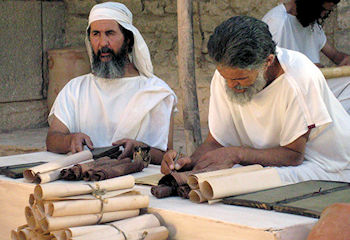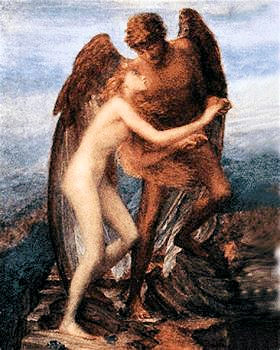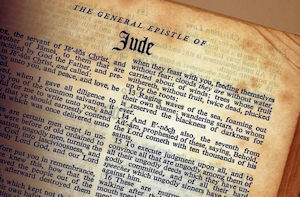To quote from Bob Dylan’s 1964 song, “the times they are a-changin’.” That certainly describes the world today, including what is happening within the Christian church. While a few church groups remain stylishly prudish or unemotionally static, others have become ‘woke’ and weakened by welcoming ungodly beliefs and unchristian activities. No one can say there isn’t a large variety of church cultures to choose from, today. Interesting though, not a single one of them presents Christianity as it was practiced and taught during the time of Jesus and his apostles.
Listen to this article: Click the > button to start audio – click again to pause – click the speaker icon to mute. Adjust volume on the right side.
But not all change is bad; some Christians are investigating the thoughts and ideology of early Christians to better understand just what Jesus and his followers believed. This small unorganized faction of seekers is searching through new research and ancient records to find satisfaction in their quest for Christian truth. Realizing God operates within the laws under which this universe was created, they critically examine not only the Holy Bible, but scientific advances as well as ancient literature to understand our creator’s methods and the influences of good and evil upon humankind. One such ancient document actively referenced is the Book of Enoch.
Even if someone doesn’t believe in some of this book’s strangeness, just knowing a little bit about Enoch’s text can be enlightening as well as entertaining. Believe me, an overview can give you an educational advantage in many biblical conversations.
When most people speak of the Book of Enoch, they are referencing what is actually titled 1 Enoch, which will be our focus of study. Other lessor manuscripts, called 2 Enoch and 3 Enoch, are much more recent literary works, but the 1 Enoch codex dates back more than two thousand years, and is assumed to be produced from even much older copies. So, just to be technically accurate, when I mention the Book of Enoch, I am specifically referencing 1 Enoch.
 This religious manuscript has often been called one of the lost books of the Bible, although that is not a correct description. Obscure may be a better label, since there have been many surviving manuscripts (or parts of manuscripts), but only in the following languages: Ethiopian Semitic (Ge’ez), Aramaic, Greek, Coptic (Egyptian), Latin, and Syriac tongues. It was accepted as genuine scripture by many early Church Fathers, such as Clement of Alexandria, Irenaeus, and Tertullian,1 but later formally rejected from canonical scripture by some influential Church leaders.
This religious manuscript has often been called one of the lost books of the Bible, although that is not a correct description. Obscure may be a better label, since there have been many surviving manuscripts (or parts of manuscripts), but only in the following languages: Ethiopian Semitic (Ge’ez), Aramaic, Greek, Coptic (Egyptian), Latin, and Syriac tongues. It was accepted as genuine scripture by many early Church Fathers, such as Clement of Alexandria, Irenaeus, and Tertullian,1 but later formally rejected from canonical scripture by some influential Church leaders.
Although widely known during the development of the Old Testament cannon, the Book of Enoch has been shunned from Hebrew scripture. This is partly because of contention from Jewish leaders, even though there remains some curiosity by Jews with mystical interests. Some scholars believe it has been rejected by Jews since the time of Christ, because it allegedly contained prophecies pertaining to Jesus.2 And the book contains unique material on the origins of demons and the Nephilim, and why some angels fell from heaven. Also because of the explanation of why the Genesis flood was morally necessary, as well as the prophetic exposition of a thousand-year reign on earth by a Messiah.3 Such thoughts were not welcome, probably because of fear to losing Jews to Christianity.
This rejection is not just derived from Jewish thought thousands of years ago, but of current times also. To drive this point home, one article from the Jerusalem Post, just a few months ago, stated this about the Book of Enoch. “What is disputed is how literally one should take it, since in Judaism, the free will and agency of angels aren’t really a factor. Angels in Judaism are seen as just messengers with no autonomy. Even Satan is but another angel doing God’s work.” It appears that belief in this book causes considerable tension among Jews.4
To learn more about fallen angels, the origins of demons and Nephilim, and the flood of Noah’s day, see the study titled “What are Demons and the Nephilim, and that Mayhem before the Flood of Noah?” listed in References & Notes at the end of this study.5
The Dead Sea Scrolls and the Essenes
Generally accepted to be written during the Second Temple Period from about 300 BC to 100 AD, there is evidence that the Enoch texts may have been used as early as the time of the First Temple (about 1000 BC).6 This belief has also been supported by other researchers.7 Many commentators believe Enoch’s book was actually authored by him and all currently known manuscripts are but copies of copies since that time. Others disagree and believe several authors’ works were consolidated to produce the book. As time passed during the millennium after Christ’s death, the Enoch manuscripts lost popularity and became known only as a lost book, especially once rejected by later Church Fathers.
 The Book of Enoch became better known in modern times after the Dead Sea Scrolls were discovered on the northwestern shore of the Dead Sea between 1947 and 1956. Approximately 900 scrolls and fragments were found in eleven caves near the ruins of Qumrān.8 These various leather and papyrus ancient manuscripts — including texts of Enoch — have helped scholars clarify the relationship between Jewish and early Christian traditions, and in dating many other archeological finds. These scrolls were found in large clay pots when a young boy shepherd was searching for a stray goat.9
The Book of Enoch became better known in modern times after the Dead Sea Scrolls were discovered on the northwestern shore of the Dead Sea between 1947 and 1956. Approximately 900 scrolls and fragments were found in eleven caves near the ruins of Qumrān.8 These various leather and papyrus ancient manuscripts — including texts of Enoch — have helped scholars clarify the relationship between Jewish and early Christian traditions, and in dating many other archeological finds. These scrolls were found in large clay pots when a young boy shepherd was searching for a stray goat.9
The Dead Sea Scrolls are believed by many scholars to be an Essene library, because that sect of Judaism once inhabited the settlement at Qumran.10 This theory currently dominates academic discussion and seems reasonable.11 Although the great majority of Jews rejected the Book of Enoch, there were small and isolated groups of adherents that believed it to be important scripture. These people were known as Essenes.
The Essene group was an obscure sect and not directly mentioned in Scripture, although a few scholars believe they may be referred to in Matthew 19:11-12.12 They practiced self-denial as a spiritual discipline and some shunned marriage to devote more time to prayer.13 Individuals did not own any private property, but shared all their possessions with others in their community. They ate simple meals, wore simple clothes, and avoided any show of luxury.14
 Essenes were interested in natural medicines and some researchers have suggested that the name Essene means ‘healer’.15 Some scholars believe John the Baptist was an Essene, because of his life style, but that is purely speculative. Many of their members had been priests associated with the Jerusalem temple, so some biblical academics support John having been an Essene, since his father had also been a temple priest (Luke 1:5-23). Also, both John and the Qumran community emphasized prophetic imagery, especially from the Book of Isaiah.16
Essenes were interested in natural medicines and some researchers have suggested that the name Essene means ‘healer’.15 Some scholars believe John the Baptist was an Essene, because of his life style, but that is purely speculative. Many of their members had been priests associated with the Jerusalem temple, so some biblical academics support John having been an Essene, since his father had also been a temple priest (Luke 1:5-23). Also, both John and the Qumran community emphasized prophetic imagery, especially from the Book of Isaiah.16
A theory has been suggested that Jesus was a member of the Essenes, too. One author believes that the unaccounted void years of Jesus’ life were spent in instruction and travel throughout Asia. It was common for Essene boys to begin their education at about the age of five in a monastery. He returned home at the age of twelve in preparation for his bar mitzvah. It was during this time that Jesus spoke and answered questions with Hebrew scholars in the temple (Luke 2:41-52). After that visit, he vanished again until finally returning home at the age of twenty-nine or thirty to begin his public ministry.17
The Essenes were but one religious sect of the Jewish population during the time of Jesus. There were three others: Pharisees, Sadducees, and Zealots. For an interesting read, see the article “Sects of Judaism During the Time of Christ” listed in References & Notes at the end of this study.18 That discourse will give insight into the culture and the personalities of biblical characters that you read about in the New Testament.
What is in the Book of Enoch?
The Book of Enoch contains several sub-books or divisions between its covers:
● the record of the angelic Watchers (chapters 1-36),
● the book of Parables (chapters 37-71),
● the Astronomical record (chapters 72-82),
● the list of Dream Visions (chapters 83-90),
● the Epistle of Enoch (chapters 91-108).19
I personally prefer hard copies for reading, however for those who are interested in reading this book without monetary investment, it is available online free to read or download; see References & Notes.20
 The book is composed of manuscripts written at different times and, sometimes, the narrative flow is a bit hard to follow. But for those who stick with it, they will find a wealth of information which gives additional details to events in our established Bible. The personal names of some angels, both righteous ones and fallen ones are given, as well as information about giants, human-angel hybrids, and how Enoch was God’s messenger to the fallen angels. And there is a strange instance about Noah’s appearance when he was first born. Whether you believe what you read is your decision, but either way it is an interesting volume.
The book is composed of manuscripts written at different times and, sometimes, the narrative flow is a bit hard to follow. But for those who stick with it, they will find a wealth of information which gives additional details to events in our established Bible. The personal names of some angels, both righteous ones and fallen ones are given, as well as information about giants, human-angel hybrids, and how Enoch was God’s messenger to the fallen angels. And there is a strange instance about Noah’s appearance when he was first born. Whether you believe what you read is your decision, but either way it is an interesting volume.
In one part of the first subdivision (chapters 6-12), Enoch is asked to communicate with the Lord in heaven and intercede for the fallen angels, who had left their heavenly home to commit immorality with the daughters of men (also see Genesis 6 in the Old Testament). He writes out the petition for the sinning angels and then retires to await the answer, which comes to him in a series of visions. This petition is refused and Enoch tells them they will have no peace because of their actions. Following this encounter, Enoch is lead by some righteous angels through various parts of the earth and Sheol.21
The overall message and conclusion of this book’s message are one of hope — reward for the righteous and punishment for the wicked. “In this book it is taught that retribution will overtake the wicked, and the righteous will have peace and prosperity, even on this earth, with the setting-up of the Messianic Kingdom . . . Then will follow the resurrection of the spirits of the righteous dead who will live forever in peace and joy, while the wicked will perish everlastingly. The important point . . . is the idea of the punishment of the wicked taking place on this earth, the very scene of their unrighteous triumphs.”22
Enoch in the Judeo-Christian Bible
In the Old Testament we are told that Enoch lived between the fall in the Garden in Eden and the great Genesis flood. He was one of seven pre-flood Patriarchs, and the father of Methuselah, that guy who lived for 969 years. He was Adam’s great-great-great-great grandson and also the great-grandfather of Noah.23 It is said that he walked with God, denoting a devout life, while living in close communion with the Lord.24 While the deaths of other Patriarchs are mentioned in scripture, this is not so for Enoch. In Genesis 5, suddenly and obscurely it states ‘and he was not’. Some commentators say he didn’t die and was immediately taken to heaven, but there are many arguments as to exactly what the scripture is implying. Here is the scripture from the Book of Genesis.
“When Enoch had lived 65 years, he fathered Methuselah. Enoch walked with God after he fathered Methuselah 300 years and had other sons and daughters. Thus all the days of Enoch were 365 years. Enoch walked with God, and he was not, for God took him” (Genesis 5:18-24, ESV).25
There are two Patriarchs in the Old Testament who supposedly did not die and who were immediately taken to heaven: Enoch and Elijah. A discussion about the possible meanings of such scripture is analyzed in “Enoch and Elijah: Are they Dead or in Heaven?” A link to that study is listed in References & Notes.26
 In the New Testament, the Book of Enoch was influential in molding doctrines about Jesus being the Son of Man, the coming messianic kingdom, demonology, and the resurrection.27 And reference to Enoch’s book is also actually cited in the NT Greek scriptures, especially the Book of Jude.
In the New Testament, the Book of Enoch was influential in molding doctrines about Jesus being the Son of Man, the coming messianic kingdom, demonology, and the resurrection.27 And reference to Enoch’s book is also actually cited in the NT Greek scriptures, especially the Book of Jude.
“It was also about these that Enoch, the seventh from Adam, prophesied, saying, “Behold, the Lord comes with ten thousands of his holy ones, to execute judgment on all and to convict all the ungodly of all their deeds of ungodliness that they have committed in such an ungodly way, and of all the harsh things that ungodly sinners have spoken against him” (Jude 1:14-15).
“And the angels who did not stay within their own position of authority, but left their proper dwelling, he has kept in eternal chains under gloomy darkness until the judgment of the great day — just as Sodom and Gomorrah and the surrounding cities, which likewise indulged in sexual immorality and pursued unnatural desire, serve as an example by undergoing a punishment of eternal fire” (Jude 1:6-7).
Conclusion
So, this Book of Enoch is an apocryphal collection of texts attributed to the great-grandfather of Noah (Genesis 5:18), which describes a group of fallen angels mating with humans. The story adds substantial evidence to support the record in Genesis, chapter 6 about the fall of angels who fathered the Nephilim. It includes predictions for the future of humanity, much of which has been incorporated into Christianity.28 If nothing else, the content recorded will give you a lot to think about, even if you find this knowledge a bit too unbelievable.
A short few decades ago, most people had never heard about this “lost” biblical book, but in today’s world, you would be surprised how many people (although still a minority group) are now examining this text about Enoch’s adventures. The song selected for this study comes from a well-liked American Christian wife, mother, and entertainer. She was someone who didn’t fit the stereotype of people researching the strange world that Enoch wrote about.
This song is quite appropriate; it is ‘The Enoch Song’. It was written and recorded in 2013 by Donna Shaw (1963-2021), a singer, song-writer, and guitarist from Lafayette, Indiana (USA). Selected lyrics are below and the music video link is listed in References & Notes.29
 When giants walked the earth before that great flood,
When giants walked the earth before that great flood,
When Satan’s seed did flow through human blood,
Enoch called them watchers.
Some thought they were gods coming down from the sky,
Now what were the odds,
Nephilim from heaven who left their first estate,
Took for them human wives and sealed their fate.
![]()
Copyright © 2023, Dr. Ray Hermann
OutlawBibleStudent.org
→ Leave comments at the end, after ‘References & Notes’.
Your email address will NOT be published. You can view our basic rules for comments by clicking “The Fine Print” on the top menu bar.
References & Notes
- “The Book of Enoch”, (Wikipedia, Wikimedia Foundation, 28 April 2023), https://en.wikipedia.org/wiki/Book_of_Enoch
- Roberts, Alexander, and Donaldson, James, (Eds.), The Ante-Nicene Fathers, (Edinburgh: T. & T. Clark, 1885), vol. 4, p. 16.
- “The Book of Enoch”, (Wikipedia), see above.
- Reich, Aaron, “The Book of Enoch: What is the famous biblical Apocrypha?” (The Jerusalem Post Newspaper, 12 December 2022), https://www.jpost.com/judaism/article-724679
- Hermann, Ray “What are Demons and the Nephilim? — and that Mayhem before the Flood of Noah?” (The Outlaw Bible Student, OBS, 29 October 2019), https://outlawbiblestudent.org/what-are-demons-and-the-nephilim-and-that-mayhem-before-the-flood-of-noah/
- Barker, Margaret, The Lost Prophet: The Book of Enoch and Its Influence on Christianity, (Sheffield, UK: Sheffield Phoenix Press, Ltd., 2005), p. 19.
- Clontz, T. E. & Clontz, J., The Comprehensive New Testament, (Macon, GA: Cornerstone Publications, 2008), pp. 562-563.
- “Qumrān”, (Encyclopaedia Britannica, 20 July 1998), https://www.britannica.com/place/Qumran
- Youngblood, Ronald, et al. (Eds.), Nelson’s New Illustrated Bible Dictionary, (Nashville, TN: Thomas Nelson Publishers, 1995).
- “Essenes”, (Wikipedia, Wikimedia Foundation, 12 April 2023), https://en.wikipedia.org/wiki/Essenes
- Ellegard, Alvar, Jesus: One Hundred Years Before Christ, (New York: Overlook Books, Abrams, 2002).
- Easton, M. G., Illustrated Bible Dictionary and Treasury of Biblical History, Biography, Geography, Doctrine, and Literature, (see above), p. 238.
- Brand, Chad, et al., (Eds.), Holman Illustrated Bible Dictionary, (Nashville, TN: Holman Bible Publishers, 2003), p. 508.
- Youngblood, Ronald F., et al., (Eds.), Nelson’s New Illustrated Bible Dictionary, (Nashville TN: Thomas Nelson Publishers, 1995).
- Kacera, Shantree, “The Essenes: An Ancient Permaculture People”, (The Living Center, 27 October 2019), https://www.thelivingcentre.com/the-essenes-an-ancient-permaculture-people/
- Charlesworth, James H., “John the Baptizer and Qumran”, (Bible Odyssey, 23 March 2022), https://www.bibleodyssey.org/passages/related-articles/john-the-baptizer-and-qumran/
- Bramley, William, The Gods of Eden, (New York: Avon Books [a HarperCollins imprint], 1990), p. 129.
- Hermann, Ray “Sects of Judaism During the Time of Christ”, (The Outlaw Bible Student, OBS, 2 April 2022), https://outlawbiblestudent.org/sects-of-judaism-during-the-time-of-christ/
- Barker, Margaret, The Older Testament: The Survival of Themes from the Ancient Royal Cult in Sectarian Judaism and Early Christianity, (Sheffield, UK: Sheffield Phoenix Press Ltd., 2005), chapter 1.
- The Book of Enoch, read free or download as PDF or Kindle or EPUB. (“The Book of Enoch”) https://book-ofenoch.com/
- Charles, R. H. (Translator) & Oesterley, W. O. E. (Introduction), The Book of Enoch, (London: Society for Promoting Christian Knowledge [SPCK], 1917), pp. xviii-xix.
- Ibid., p. xxiii.
- Bolinger, Hope, “Who Was Enoch in the Bible?” (Christianity, 5 May 2021), https://www.christianity.com/wiki/bible/who-was-enoch-in-the-bible.html
- Grant, A. C., “Enoch,” (Ed.) James Orr, et al., The International Standard Bible Encyclopaedia, (Chicago: The Howard-Severance Company, 1915), vol. 2, p. 953.
- Unless otherwise indicated, all scripture is quoted from The Holy Bible: English Standard Version, (Wheaton, IL: Crossway Bibles, 2016). Used by permission.
- Hermann, Ray, “Enoch and Elijah: Are they Dead or in Heaven?” (The Outlaw Bible Student, OBS, 11 May 2020), https://outlawbiblestudent.org/enoch-and-elijah-are-they-dead-or-in-heaven/
- Isaac, Ephraim, “1 Enoch: A New Translation and Introduction” in The Old Testament Pseudoepigrapha, (Ed.), James Charlesworth, (New Haven, CT: Yale University Press, 1983), vol. 1, p. 10.
- “Book of Enoch”, (New World Encyclopedia, retrieved 3 May 2023), https://www.newworldencyclopedia.org/entry/Book_of_Enoch
- “The Enoch Song”, Artist: Donna Kay Shaw; Original song, “Ancient Evil” written by Donna Kay Shaw; music track help by Joe Garrison, 2013; (no copyright information, no licensing information). Used under ‘fair use copyright’ for teaching under Section 107 of the United States Copyright Act of 1976 — MUSIC VIDEO: https://youtu.be/nvfhIB4L6iU


Hello Ray, good story, enjoyed your read concerning Enoch. I myself often have been asked about the book of Enoch. Thank you for explaining there are three different versions. I have read through parts of all of them, so I think.
I’ve switch to and almost completed 1 Enoch enlighten me that this was the book to read.
What I don’t get is how did this book make it past the flood? There’s no record in the Bible of God having Noah bring any writings upon his ship.
The other part would be, I didn’t know there were any manuscripts written, or even the art of writing such things existed before the times of Noah.
When I’ve been asked about the book of Noah I’ve asked people to be very careful about taking it literally, that I had questions whether it was authentic or not because of just what I mentioned above. Just because it was found as part of other biblical literature, can it really consider to be a true document?
I am just curious about how and where it actually came from. Please, what are your thoughts?
And thank you for your emails, there’s a lot of good stuff on your website. I have to say also on the less spiritual side but still could express some truth and that is your joke section. I’ve shared many of your jokes with others and they’ve really enjoyed the humor. Too many people believe that Christians can’t express humor in the way of jokes or storytelling.
God Bless you Ray and your ministry and take care.
Many sources are quick to point out that 1 Enoch dates back only to 300-200 BC. This doesn’t mean it is only that old, but only in its current form since then. Some parts have been found much older as parts of other ancient documents, especially carved in stone. I would assume that at some point, various similar pieces were collected and documented in separate scrolls.
Others state the oldest religious books found were only written no earlier than 1000-800 BC. But as the British Library* points out, writing-systems were independently invented at least four times in human history and samples date back to 3400 BC — that is nearly 5500 years ago, well before the flood.
As far as the Book of Noah is concerned (or any written stories before the flood), I would imagine some stone documents could have been carried on Noah’s Ark, although not mentioned in the Bible. Or the information could have been later documented from oral stories. That is purely speculation, of course. I have not yet studied the Book of Noah, so I am unqualified to make much comment, especially about its authenticity.
Thank you for your comments and for your kind words. And I’m glad you enjoy the jokes found in our “Funnies” section.
* Clayton, Ewan, “Where did writing begin?” (British Library, British Library Board, retrieved August 14, 2023),
https://www.bl.uk/history-of-writing/articles/where-did-writing-begin